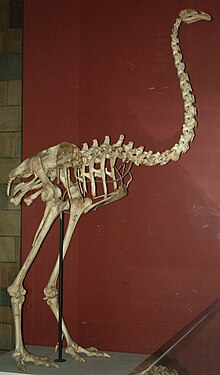| Moa | |
|---|---|

| |
| North Island giant moa skeleton | |
| Scientific classification | |
| Kingdom: | Animalia |
| Phylum: | Chordata |
| Class: | Aves |
| Infraclass: | Palaeognathae |
| Clade: | Notopalaeognathae |
| Order: | †Dinornithiformes Bonaparte, 1853[1] |
| Type species | |
| †Dinornis novaezealandiae Owen, 1843
| |
| Subgroups | |
|
See text | |
| Diversity[2] | |
| 6 genera, 9 species | |
| Synonyms[3] | |
| |
Moa[note 1] (order Dinornithiformes) are an extinct group of flightless birds formerly endemic to New Zealand.[4][note 2] During the Late Pleistocene-Holocene, there were nine species (in six genera). The two largest species, Dinornis robustus and Dinornis novaezelandiae, reached about 3.6 metres (12 ft) in height with neck outstretched, and weighed about 230 kilograms (510 lb)[5] while the smallest, the bush moa (Anomalopteryx didiformis), was around the size of a turkey.[6] Estimates of the moa population when Polynesians settled New Zealand circa 1300 vary between 58,000[7] and approximately 2.5 million.[8]
Moa are traditionally placed in the ratite group.[4] However, their closest relatives have been found by genetic studies to be the flighted South American tinamous, once considered to be a sister group to ratites.[9] The nine species of moa were the only wingless birds, lacking even the vestigial wings that all other ratites have. They were the largest terrestrial animals and dominant herbivores in New Zealand's forest, shrubland, and subalpine ecosystems until the arrival of the Māori, and were hunted only by the Haast's eagle. Moa extinction occurred within 100 years of human settlement of New Zealand, primarily due to overhunting.[7]
https://en.wikipedia.org/wiki/Moa
No comments:
Post a Comment